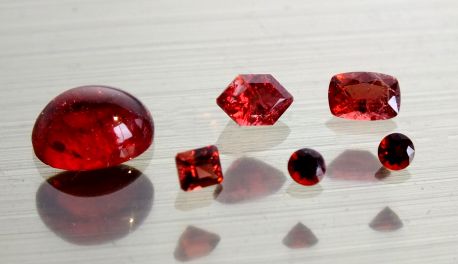 |
| 研磨されたユージアル石 0.08 -
2.28ct (Polished and faceted Eudialyte) |
ユージアル石 (Eudialyte)
 |
| 研磨されたユージアル石 0.08 -
2.28ct (Polished and faceted Eudialyte) |
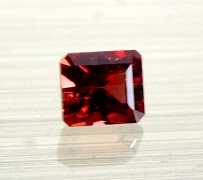 |
 |
 |
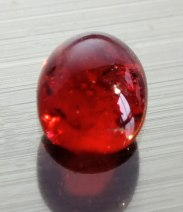 |
| 0.17ct 3.2x2.8mm | 0.36ct 5.6x3.9mm | 0.47ct 6.0x4.0mm | 2.28ct 9.0x7.0mm |
| Sheffield Lake | Kipawa River | Kipawa Basin | |
| Quebec, Canada | |||
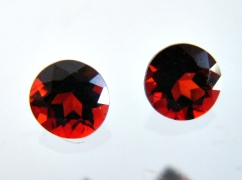 |
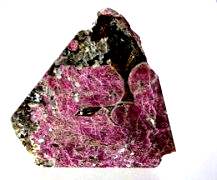 |
| Ø2.3mm 0.08ct. ea. | 研磨されたユージアル石 9x7cm |
| Lovozero, Khibiny, Kola Peninsular, Russia | |
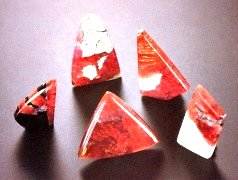 |
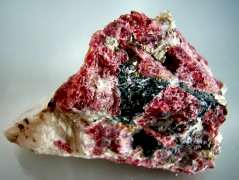 |
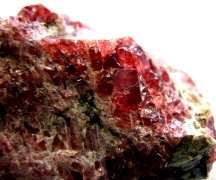 |
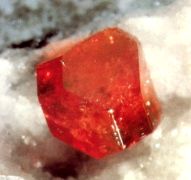 |
| 白い長石を含むカボション Eudialyte(reddish orange) with albite(white) 2- 3ct |
宝石質部を含む結晶 49x27mm
Eudialyte with gemmy crystal |
宝石質結晶部の拡大 magnified view |
ユージアル石結晶 1.5mm Eudialyte crystal 1.5mm Horváth collection |
| Kipawa Basin | Mont Saint Hilaire | ||
| Quebec,
Canada | |||
アグレル石(50mm)中のユージアル石結晶(8mm)
Eudialyte crystal(8mm) in Agrellite: NaCa2[F/Si4O10](50mm)
Kipawa Basin, Quebec, Canada短波長紫外線(235nm)で
蛍光を発するアグレル石
Agrellite shwon under
short wave UV(235nm)
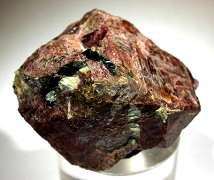 |
 |
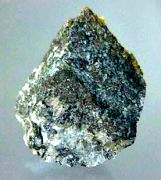 |
| Eudialyte crystal
5x4x3cm Nanjakasik, Ilimasauq, Greenland |
45x40mm Norra Kärr, Sweden |
40x30mm, Jungni Hill, Malawi |
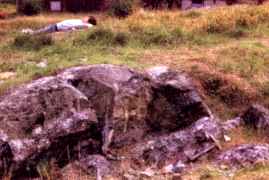 |
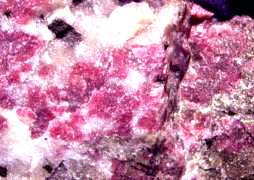 |
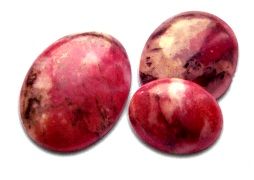 |
| ユージアル石を含む母岩 Grännaite Eudialyte is discovered as red phenocryst in rock called Grännaite |
明るい赤のユージアル石 Bright red Eudialyte |
白い曹長石と黒いアルフフェドソン石 を含むユージアル石のカボション Eudialyte cabochon with white albite and black arfvedsonite |
| Norra Kärr alkaline complex, Sweden | ||
| 化学組成(Composition) | Na15Ca7,Fe3Zr3Si[Cl/Si3O9/Si9O27/(OH,Cl)] |
| 結晶系(Crystal system) | 三方晶系 (Trigonal) |
| 結晶形(Crystal Form ) |  |
| モース硬度 (Hardness) | 5 - 6 |
| 比重(Density) | 2.60 - 3.10 |
| 屈折率(Refractive Index) | 1.599-602 |
名前について (About name)
ユージアル石の名はこの鉱物が酸に良く溶けることから、ギリシア語の”Eu=良く、とDialusis=溶解する”とを合成してつけられました。
ロシアの鉱物学者、A・フェルスマンの名著 ”石の思い出”(理論社 1956年刊行、永らく絶版となっていましたが、2005年、多少内容を変えて復刊)を読まれた方は、”ツンドラ一面に飛び散ったラップランド人の血の石,ヒビ−ヌイ山地にある際だって赤い鉱物、ユージアル石 ・・・” を憶えていることでしょう。
実に半世紀近くもの期間、それがどんな鉱物なのか、ただ思いを巡らすのみでありました。
ユージアル石が鉱物や宝石市場に出まわるようになったのはつい最近のことです。
Eudialyte is named after Greek "Eu : well and Dialusis : soluble" for it's solubility in acids.
In spite of its rarity, eudialyte is well memorized by mineral collectors for poetic descriptions in " Reminiscenses about Minerals" written by Russian mineralogist, A.E. Fersman. It took almost half century until we could see what is eudialyte, the extreme vermillion colored mineral, like Lapp's blood. Specimens of eudialyte appeared in mineral market recently, although as scarece specimen yet.
産地と産状 (Origin and Occurence)
ユージアル石はアルカリとジルコニウム分に富むアルカリ貫入岩,とりわけ霞石閃長岩ペグマタイト地帯に発見されます。
産地は主にグリーンランド、ロシアのコラ半島、カナダのケベック州、ノルウェー等、何故か北極圏に偏在していますが、赤道ギニア、マダガスカル、南アフリカでも報告されています。
ロシアのコラ半島のヒビーヌイ高地とロヴォゼロ・ツンドラ地帯からノルウェーのランゲスンズ・フィヨルドに至るラップ人の地にはユージアル石がアルカリ貫入岩の主成分として豊潤に存在します。
他のジルコニウム鉱物に乏しいロシアでは原子炉に欠かせないジルコニウム資源としてユージアル石の積極的な開発と採掘とを行いました。全ての元素の中でジルコニウムは中性子を殆ど吸収しないという特性があります。
中性子によるウランやプルトニウムの核分裂を利用する核燃料収納用の材料として不可欠の金属です。
市場に出まわる標本の大半はロシアのコラ半島とカナダのケベック産のもの。
この二つの地域は地質が非常に似ていて、他には見られない共通の稀な鉱物が多いことが特徴です。
数ある鉱物の中で最も複雑な組成を持つ鉱物の一つに挙げられるでしょう。
上記の化学組成は比較的単純なものを使いましたが、あくまでも参考。
他にマンガン、ニオブ,チタン、セリウム等を含み,産地によりかなり異なります。従って、比重と屈折率の数字も変わってくるでしょう。
最近の研究ではユージアル石は単独ではなくその大半が稀な種類の広範な鉱物群の一つであるとされています。
現在分かっているだけでも ; alluaivite, aqualite, carbokentbrooksite, eudialyte, feklichevite, labyringhite, manganokhomyakovite, oneillite, raslakite, rastsvetaevite, sirsillite-(Ce), tasequite, ・・・・まだまだ続くのですが、いずれも上記の化学組成の元素を共通に、しかし少しずつ異なる割合で含むグループです。
色は赤や赤紫が一般的ですが資料によると褐色、黄色、緑もあるとのことです。
Eudialyte occurs mostly in so-called alcaline intrusions, rich in aluminium and zirconium, particularly in nephline syenites and their pegmatites. It was first discovered near Narsaq in Western Greenland. Eudialyte is fairly abundant as a rock-forming mineral in the alkaline complexes of Lovozero and khibinyi in the Kola Peninsular, Russia and of Langensundsfjord, Norway. It also occurs in Guinea, Madagascar、South Africa and in U.S.A. Kipawa Basin, Quebec, Canada is known for gemmy crystals.
Eudialyte is potentially a zirconium ore. Russia, who has not any major deposits of accessible zirconium, had extensively explored the Kola Penisula. Zirconium alloys are used to encapsulate fuel rods in nuclear reactors ; zirconium lets nutron pass, which is an essential factor that nuclear fission reaction starts.
Do you notice that chemical formula in the box is quite complex ? But this is simplifed one, yet. It always took a very tolerant view to consider eudialyte a single mineral, and the term "eucolite" has been used for calcium-rich eudialyte.
The specific gravity varies within about +/- 10%, birefringence is positive or negative, and chmical composition is all over the place! Recent research has proven that eudialyte is not just eudialyte but an entire group of minerals, most of which are rare. Currently the eudialyte group includes the approved species ; alluavite, aqualite, carbokentbrookside, eudialyte, feklichevite, labyrinthite, manganokhomyakite, oneillite, raslakite, rastsvetaevite, zirsilite-(Ce). And more are coming ! Colors are ; brown, reddish brown, bright red, yellow, even green or purple.
宝石質のユージアル石 (Gem quality eudialyte)
多くは団塊でしか産しないユージアル石ですが、稀に宝石質の透明な部分がファセットやカボションカットされたものを市場で見かけます。
4列目左の写真は1999年に45kgも採取され、その一部が宝飾品として母岩ごと研磨されたものです。こうした透明度の高い結晶はカナダのケベック州の特産。
しかしファセット・カットされたものとなると5年に1度見かける程度です。
しかも最大でも0.5ct以下と小さなルースしか採れません。
今回カナダ産の比較的大きなカボションとロシア、コラ半島ロヴォゼロ・ツンドラ産のユージアル石のファセットを入手しました。
カナダ産のカボションは2カラットを越える大きさです。
インクルージョンが多いためファセットではなくカボション・カットされましたが、大きく色合いの美しいものです。
ロシア産は二つで0.16カラットと小さいながらカナダ産とはかなり色合いが異なります。
恐らく成分比がかなり異なるためでしょう。
ともあれ、鉱物標本にも透明な宝石質の結晶が見かけられないコラ半島産のユージアル石ですから、こんなに小さいながらもファセット・カットされた石は貴重です。
小さい上に硬度も高くはなく,酸にも溶けるユージアル石は耐久性に欠けるため一般の宝石用には向きません。
しかし,複雑な化学成分のせいでしょう、独特の味わい深い色合いは魅力があります。
Most of eudialyte crystals are opaque and rarely shows crystal form. Quite rarely, facetted or cabochon cut stones appear in the market.
Left photo in 4th low from top shows free cabochon cut stones, collected as much as 45kg of gemmy crystals in 1999. Almost all gemmy crystals are collected from Quebec, Canada, once for every 5 year and the biggest stone is as small as less than 0.5ct.
Faceted eudialyte from Lovozero, Kola Peninsular, Russia is quite rare. Although extremely small, this is the first faceted stone, I have ever seen from this locality.
Top Gemhall